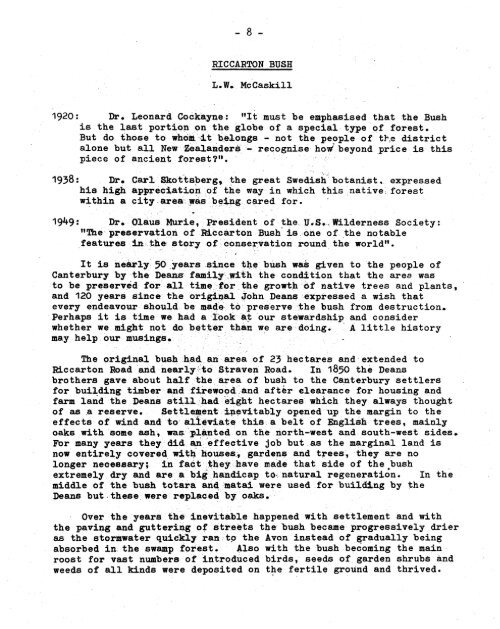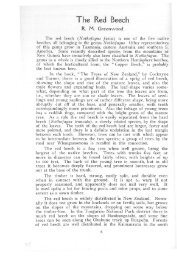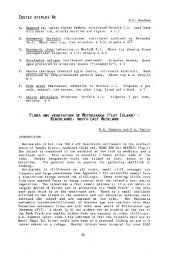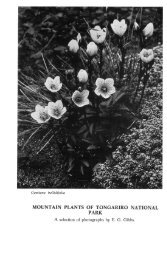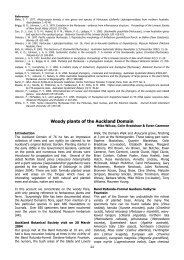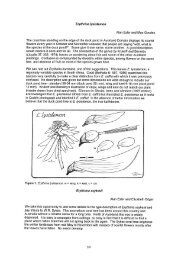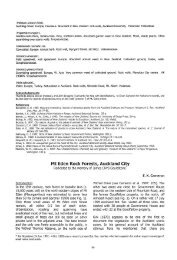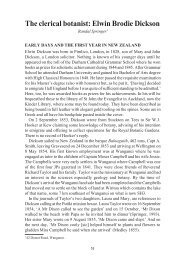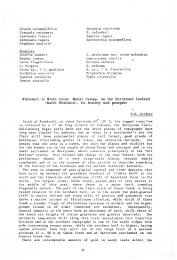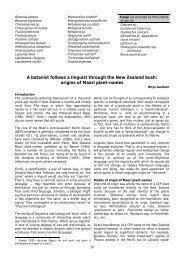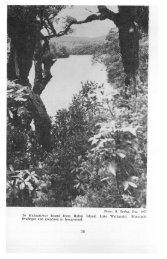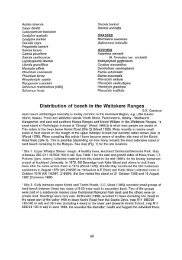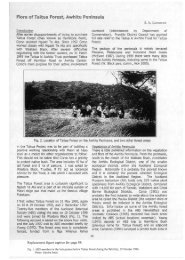Dr. Leonard Cockayne: "It must be emphasised that the Bush is the ...
Dr. Leonard Cockayne: "It must be emphasised that the Bush is the ...
Dr. Leonard Cockayne: "It must be emphasised that the Bush is the ...
- No tags were found...
Create successful ePaper yourself
Turn your PDF publications into a flip-book with our unique Google optimized e-Paper software.
- 8 -RICCARTON BUSHL.W. McCaskill1920: <strong>Dr</strong>. <strong>Leonard</strong> <strong>Cockayne</strong>: "<strong>It</strong> <strong>must</strong> <strong>be</strong> <strong>emphas<strong>is</strong>ed</strong> <strong>that</strong> <strong>the</strong> <strong>Bush</strong><strong>is</strong> <strong>the</strong> last portion on <strong>the</strong> glo<strong>be</strong> of a special type of forest.But do those to whom it <strong>be</strong>longs - not <strong>the</strong> people of th.e d<strong>is</strong>trictalone but all New Zealanders - recogn<strong>is</strong>e how? <strong>be</strong>yond price <strong>is</strong> th<strong>is</strong>piece of ancient forest?",1938: <strong>Dr</strong>. Carl Skotts<strong>be</strong>rg, <strong>the</strong> great Swed<strong>is</strong>h botan<strong>is</strong>t, expressedh<strong>is</strong> high appreciation of tne way in which th<strong>is</strong> native-, forestwithin a city area was <strong>be</strong>ing cared for,19^9: <strong>Dr</strong>. Olaus Murie, President of <strong>the</strong> U.S. Wilderness Society:"The preservation of Riccarton <strong>Bush</strong> <strong>is</strong> one of <strong>the</strong> notablefeatures in <strong>the</strong> story of conservation round <strong>the</strong> world".<strong>It</strong> <strong>is</strong> nearly 50 years since <strong>the</strong> bush was given to <strong>the</strong> people ofCanterbury by <strong>the</strong> Deans- family with <strong>the</strong> condition <strong>that</strong> <strong>the</strong> area wasto <strong>be</strong> preserved for all time for <strong>the</strong> growth of native trees and plants,and 120 years since <strong>the</strong> original John Deans expressed a w<strong>is</strong>h <strong>that</strong>every endeavour should <strong>be</strong> made to preserve <strong>the</strong> bush from destruction.Perhaps it <strong>is</strong> time we had a look at our stewardship and considerwhe<strong>the</strong>r we might not do <strong>be</strong>tter than we are doing. A little h<strong>is</strong>torymay help our musings.The original bush had an area of 23 hectares and extended toRiccarton Road and nearly to Straven Road. In.-1-850. <strong>the</strong> Deansbro<strong>the</strong>rs gave about half <strong>the</strong>. area of bush to <strong>the</strong> Canterbury settlersfor building tim<strong>be</strong>r and firewood.and after clearance for housing andfarm land <strong>the</strong> Deans still had eight hectares which <strong>the</strong>y always thoughtof as a reserve. Settlement inevitably opened up <strong>the</strong> margin to <strong>the</strong>effects of wind and to alleviate th<strong>is</strong> a <strong>be</strong>lt of Engl<strong>is</strong>h trees, mainlyoaks with some ash, was planted on <strong>the</strong> north-west and south-west sides.For many years <strong>the</strong>y did an effective job but as <strong>the</strong> marginal land <strong>is</strong>now entirely covered with houses f gardens and trees, <strong>the</strong>y are nolonger necessary; in fact <strong>the</strong>y have made <strong>that</strong> side of <strong>the</strong> bushextremely dry and are a big handicap to natural regeneration. In <strong>the</strong>middle of <strong>the</strong> bush totara and matai were used for building by <strong>the</strong>Deans but <strong>the</strong>se were replaced by oaks.Over <strong>the</strong> years <strong>the</strong> inevitable happened with settlement and with<strong>the</strong> paving and guttering of streets <strong>the</strong> bush <strong>be</strong>came progressively drieras <strong>the</strong> Stormwater quickly ran tp <strong>the</strong> Avon instead of gradually <strong>be</strong>ingabsor<strong>be</strong>d in <strong>the</strong> swamp forest. Also with <strong>the</strong> bush <strong>be</strong>coming <strong>the</strong> mainroost for vast num<strong>be</strong>rs of introduced birds, seeds of garden shrubs andweeds of all kinds were deposited on <strong>the</strong> fertile ground and thrived.
- 9 -(Th<strong>is</strong> still happens of course and at least one hundred exotic specieshave .<strong>be</strong>en found in <strong>the</strong> area, some of <strong>the</strong>m*serious competitors bf regeneratingnatives). By 191^ <strong>the</strong>n, although <strong>the</strong> reserve still lookedlike a swamp forest it was overrun with black<strong>be</strong>rry,, elder<strong>be</strong>rry, wildcherries, ash f oak, sycamore and a host of o<strong>the</strong>r foreigners. So th<strong>is</strong>was <strong>the</strong> condition which faced <strong>the</strong> Board of Trustees which took controlof <strong>the</strong> bush when <strong>the</strong> Deans family gave an area of 6.3 hectares to <strong>the</strong>people of Canterbury in 1914. A ranger, John F. Tickell was appointed,and <strong>the</strong> Chr<strong>is</strong>tchurch City Council built a house for him", and helped payh<strong>is</strong> salary for <strong>the</strong> next 16 years. As a one-man band he did a tremen*dous job in tackling <strong>the</strong> weeds and cutting out many of <strong>the</strong> exotic treeson <strong>the</strong> southside•The diminutive Len Armstrong was ranger from .1935 until 1957•One of hi£ early jobs was <strong>the</strong> removal of oaks in tne interior of <strong>the</strong>bush and he persevered with <strong>the</strong>se until in 1950 he had cut and sawn<strong>the</strong> last of <strong>the</strong>m, and pushed <strong>the</strong> logs to <strong>the</strong> gate in a wheel barrow.The whole of <strong>the</strong> cleared area has long <strong>be</strong>en a broadleaved thicket withpokaka, kahikatea and lancewood regenerating freely. Armstrong'sstruggles with <strong>the</strong> smaller weeds were aided by students of <strong>the</strong>Teachers Training College. As part of <strong>the</strong>ir practical work for <strong>the</strong>irbiology certificates <strong>the</strong>y were required to spend two hours pullingweeds. On Saturdays in <strong>the</strong> mornings for several weeks in <strong>the</strong> yearfrom 1935 to 1 9^5 <strong>the</strong> paths were piled high with <strong>the</strong> annual crop ofweed growth. One of <strong>the</strong> useful jobs <strong>the</strong> students did was to reduce<strong>the</strong> harmful effects of <strong>the</strong> native Muehlen<strong>be</strong>ckia austral<strong>is</strong> or pohuehuea scrambler clim<strong>be</strong>r which had greatly increased with <strong>the</strong> increasedlight provided by tracks and <strong>the</strong> removal of oaks. Th<strong>is</strong> plant shouldalways <strong>be</strong> considered a major enemy of many~of <strong>the</strong> o<strong>the</strong>r natives.By 1945 <strong>the</strong> drying out of <strong>the</strong> bush liad produced serious effects;all <strong>the</strong> matai were dead and most of <strong>the</strong> totara, and natural regenerationwas insufficient to replace <strong>the</strong>m. Then came <strong>the</strong> big storm of 14thJuly 1945 when 18 inches pf snow sat on <strong>the</strong> trees and <strong>the</strong> masses ofpohuehue doing tremendous damage.The heavy frosts following <strong>the</strong> snow killed all <strong>the</strong> titoki trees.The original trees which grew in <strong>the</strong> bush were said to have <strong>be</strong>en killedin <strong>the</strong> big frost in <strong>the</strong> l860-'s when Lyttelton Harbour had iee on it.Some had <strong>be</strong>en planted in 1925• When <strong>the</strong> mess was cleared up muchground was exposed to <strong>the</strong> incoming of weeds but it also provided spacefor <strong>the</strong> planting of nursery*-grown totara and kahikatea donated by <strong>the</strong>Education Board. <strong>It</strong> was obvious <strong>that</strong> <strong>the</strong> future of <strong>the</strong> bush <strong>must</strong>depend on silvicultural practices and a nursery was establ<strong>is</strong>hed inwhich many hundreds of kahikatea, totara and matai were propagated.The pupils of Moana, Ahaura and Totara Flat Schools in Westland tooka great interest in <strong>the</strong> project and collected hundreds of seedlingsof <strong>the</strong> three podocarps.
- 10 -In 1946 <strong>the</strong> Deans family proposed to sell <strong>the</strong> Riccarton Housesite and adjoining parkland and private bush for housing. Mr. W.B.Brockie, <strong>the</strong> Royal Society representative on <strong>the</strong> Board of Trustees,considered it was vital to <strong>the</strong> future of <strong>the</strong> bush, to acquire <strong>the</strong>Deans land and reserve it for a.ll- time. The Canterbury ProgressLeague called a public meeting in August 19*f6with <strong>the</strong> result <strong>that</strong><strong>the</strong> Chr<strong>is</strong>tchurch City Council, Riccarton Borough Council and <strong>the</strong>Waimairi, Paparua and Heathcote County Councils agreed to purchase<strong>the</strong> property, to add it to Riccarton <strong>Bush</strong> and provide future annualfinance by rating. The new arrangement came into" force in March19^8 and early successful attention was given to <strong>the</strong> improvement of<strong>the</strong> parkland to make it suitable for public use. A big problem was<strong>the</strong> two hectares of private bush added on <strong>the</strong> north-east side. Inaddition to <strong>be</strong>ing overgrown with black<strong>be</strong>rry, elder<strong>be</strong>rry, ash, sycamoreand spindle trees <strong>the</strong> area had long <strong>be</strong>en used as a rubb<strong>is</strong>h dump.The herculean efforts of Armstrong and h<strong>is</strong> ass<strong>is</strong>tant aided by <strong>the</strong>Forest and Bird Protection Society produced <strong>the</strong> transformation to <strong>be</strong>seen today. The weeds were cut and burned, <strong>the</strong> rubb<strong>is</strong>h was cartedaway and^many hundreds of trees and shrubs planted and subsequentlycarefully tended. Th<strong>is</strong> area <strong>be</strong>tter than any o<strong>the</strong>r demonstrates howsuccessful silvicultural practices can <strong>be</strong> in preserving and extendinga piece of native bush.The brief remark in <strong>the</strong> 1950 report to <strong>the</strong> Royal Society: "Thelast large totara which had <strong>be</strong>en dead for many years <strong>be</strong>came dangerousand was felled"; hid <strong>the</strong> true story. Growing at <strong>the</strong> nor<strong>the</strong>rn endof <strong>the</strong> private bush th<strong>is</strong> totara, four feet in diameter, rose kO feetto <strong>the</strong> first branch and <strong>the</strong> spreading top. Ohe Saturday morningwith several mem<strong>be</strong>rs of <strong>the</strong> Forest and Bird Society, I was cuttingblack<strong>be</strong>rry while Armstrong burned it. A spark caught <strong>the</strong> powderedbark in <strong>the</strong> high fork of <strong>the</strong> tree and soon <strong>the</strong> crown was well alight.The Chr<strong>is</strong>tchurch Fire Brigade arrived promptly but all <strong>the</strong>ir enginepower and all <strong>the</strong> water in <strong>the</strong> Avon could not reach <strong>the</strong> flames. Theforeman's dec<strong>is</strong>ion was: "You cut <strong>the</strong> tree down and call us back toput out <strong>the</strong> fire" - Un<strong>be</strong>lieveable? - but true. So Armstrong and Isawed for well over aii hour, <strong>the</strong> Brigade arrived, someone got somefine tim<strong>be</strong>r, and <strong>the</strong> magnificent stump <strong>is</strong> <strong>the</strong>re today.Subsequent work in <strong>the</strong> enlarged bush has involved control ofweeds, improvement of paths, planting of bare ground with nurserygrownstock, but above all <strong>the</strong> introduction of irrigation after asuccessful trial in 1959* Using poly<strong>the</strong>ne piping much of <strong>the</strong> bushcan now <strong>be</strong> kept wet in dry periods and th<strong>is</strong> has <strong>be</strong>en an importantfactor in <strong>the</strong> <strong>be</strong>tter condition of many of <strong>the</strong> large trees and in <strong>the</strong>establ<strong>is</strong>hment and growth of <strong>the</strong> young ones.My study of <strong>the</strong> bush has led me to <strong>the</strong> following conclusions :-
- 11 -(1) An area of about two hectares, in <strong>the</strong> middle and to <strong>the</strong> Southwest,can <strong>be</strong> considered to <strong>be</strong> so nearly natural in condition<strong>that</strong> we may <strong>be</strong> able to prevent any major deterioration. <strong>It</strong>will need irrigation when required, extermination of weeds(especially <strong>the</strong> Engl<strong>is</strong>h, male fern), and judicious control ofpohuehue.* Possibly, and regrettably, it may have to <strong>be</strong> fenced.(2) Treating <strong>the</strong> rest of <strong>the</strong> bush in broad terms I would advocate:(a)(b)(c)(d)(e)Reducing <strong>the</strong> num<strong>be</strong>r of tracks to ensure less exposure insome critical areasThe war on weeds <strong>must</strong> <strong>be</strong> looked on as one which willalways <strong>be</strong> with usAnnual plantings of bare spaces in <strong>the</strong> interior of <strong>the</strong>bush should <strong>be</strong> continued, followed by release from competition.Hinau should <strong>be</strong> included (<strong>the</strong>re are only twotrees left).The mass of oak, ash, sycamore and poplar on <strong>the</strong> southand south-west margins should <strong>be</strong> removedThe <strong>be</strong>lt of oaks on <strong>the</strong> north-west margin should <strong>be</strong>removed in two stages - <strong>the</strong> innermost trees now and <strong>the</strong>remainder in a few years(f) « A 10-year plan should <strong>be</strong> prepared for <strong>the</strong> close plantingwith natives of all open spaces in <strong>the</strong> margins,The action suggested will not restore <strong>the</strong> primeval character,structure and composition of <strong>the</strong> bush but it would give us for alltime in <strong>the</strong> heart of th<strong>is</strong> big city, a complete collection of <strong>the</strong>plants originally growing in <strong>the</strong> bush, growing in an association notso very different v<strong>is</strong>ually from <strong>that</strong> which greeted <strong>the</strong> pioneers.CAREXINOPINATABy: John ThompsonCarex inopinata has <strong>be</strong>en found only in <strong>the</strong> limestone country in<strong>the</strong> Castle Hill Basin* I collected a small portion of th<strong>is</strong> sedge,with leaves up to 8 cm. long, on <strong>the</strong> 25th March, 1972 and placed itin a 6 inch pot in ordinary potting soil to which a heavy dressingof crushed limestone had <strong>be</strong>en added.By <strong>the</strong> 31st Decem<strong>be</strong>r 1972 <strong>the</strong> plant had spread completely filling<strong>the</strong> pot with a very thick healthy growth of leaves up to &Jcm. long.The roots had reached <strong>the</strong> bottom of <strong>the</strong> pot around its sides but hadonly grown 5 cm. long in <strong>the</strong> centre, due perhaps to inadequatewatering.


